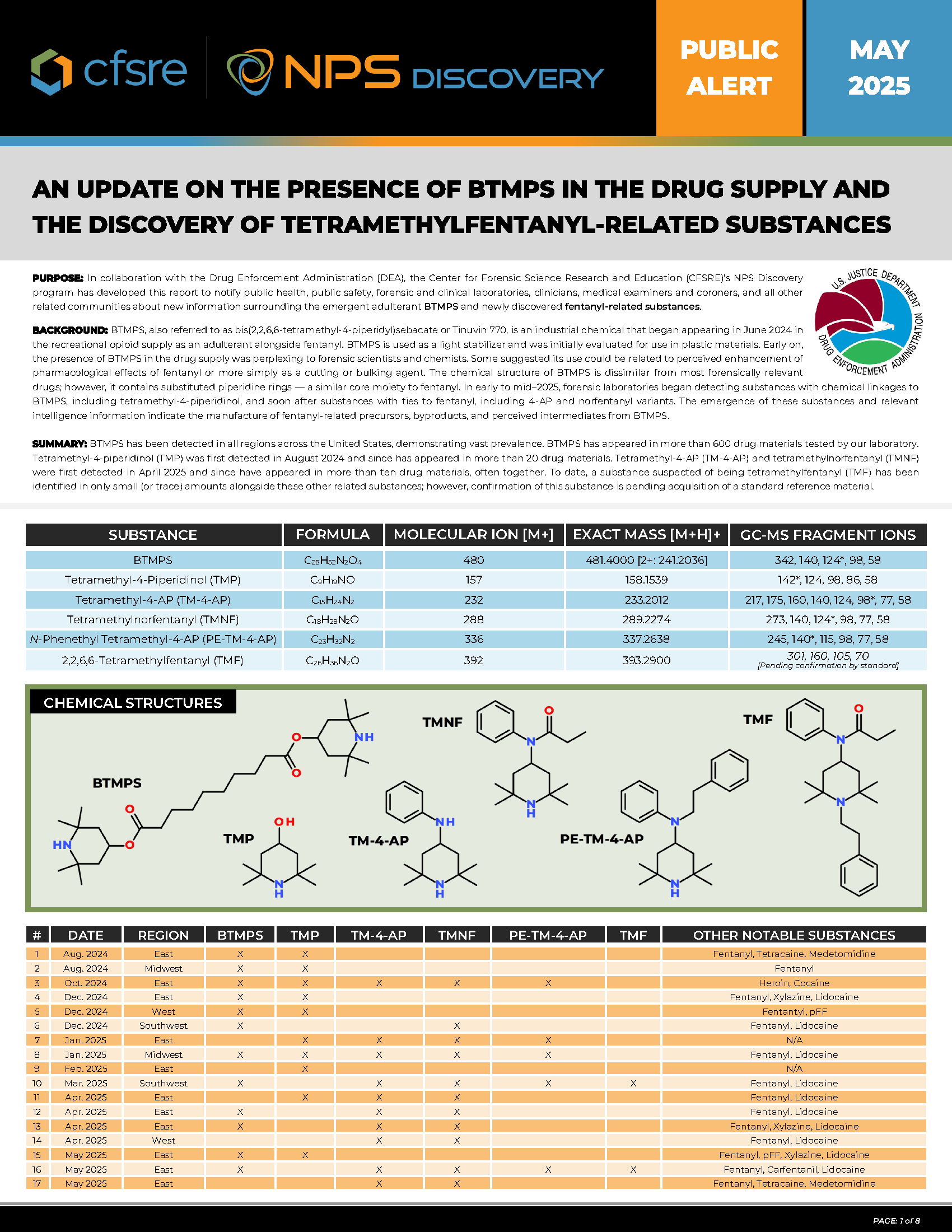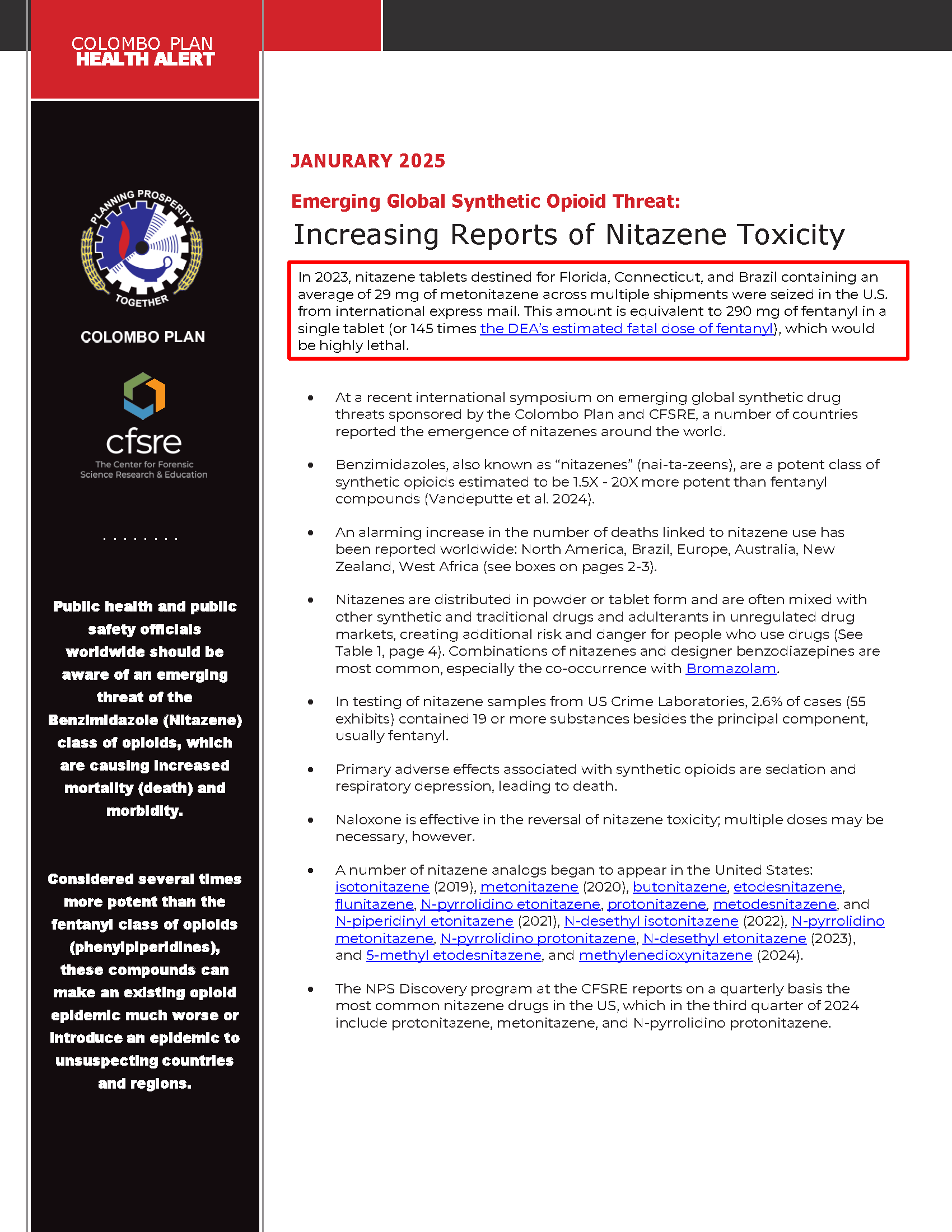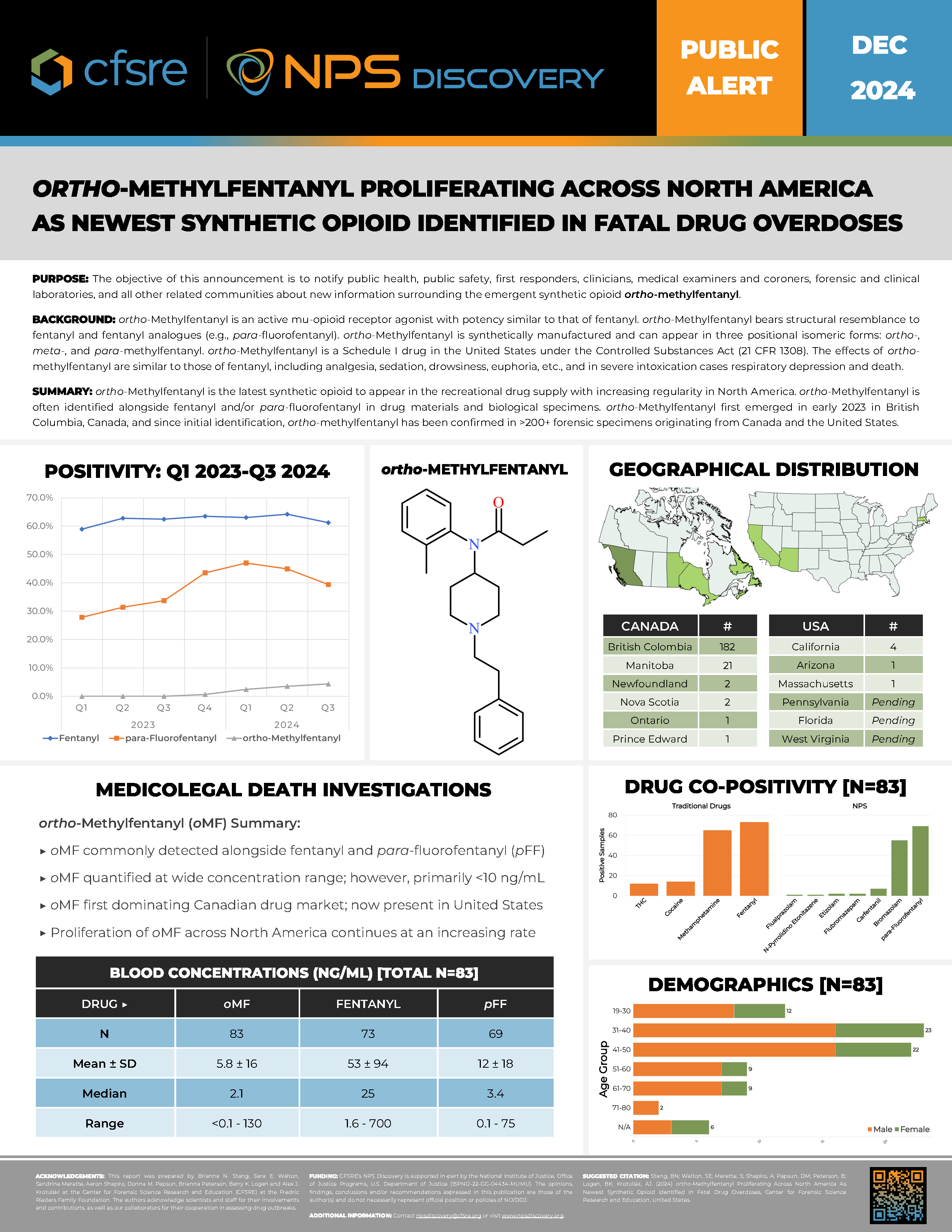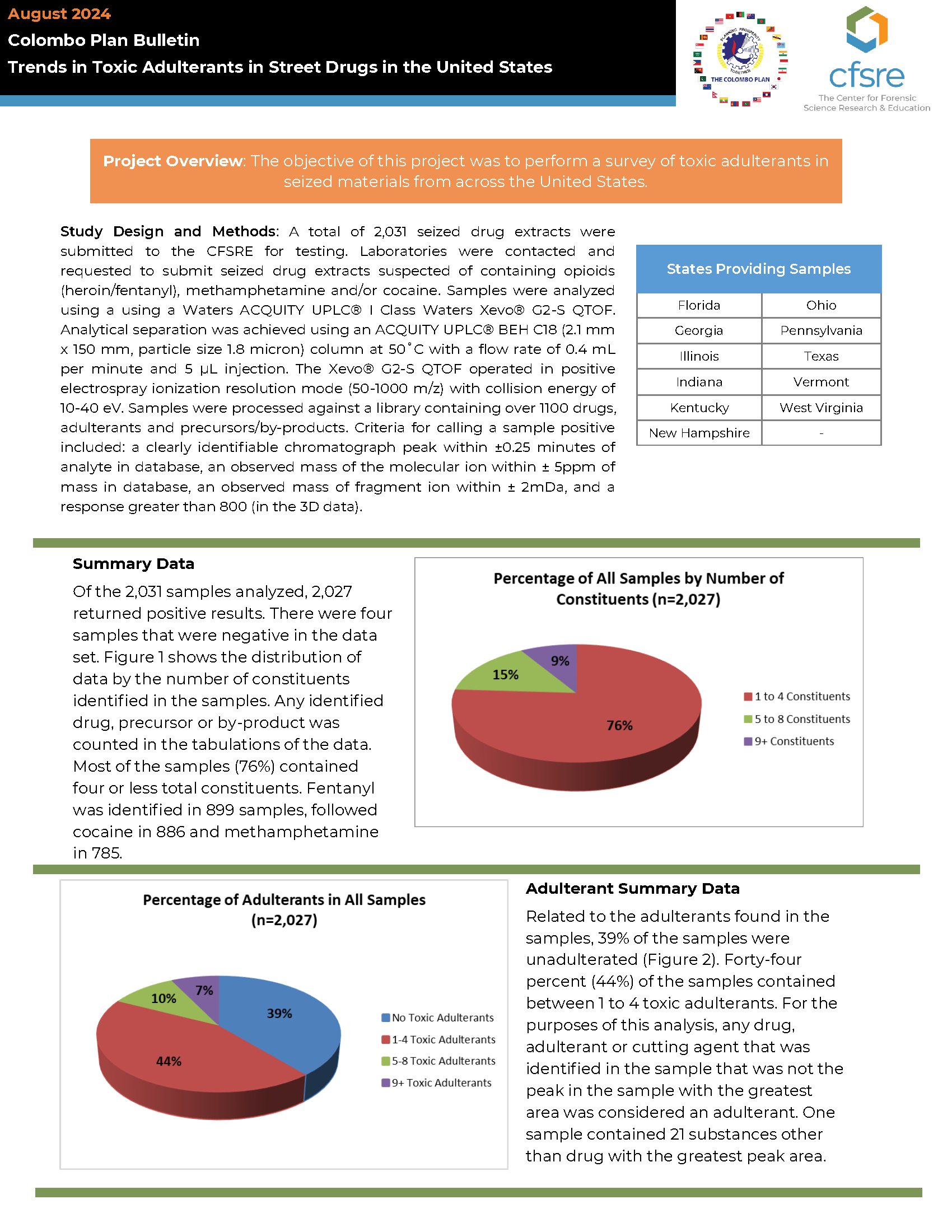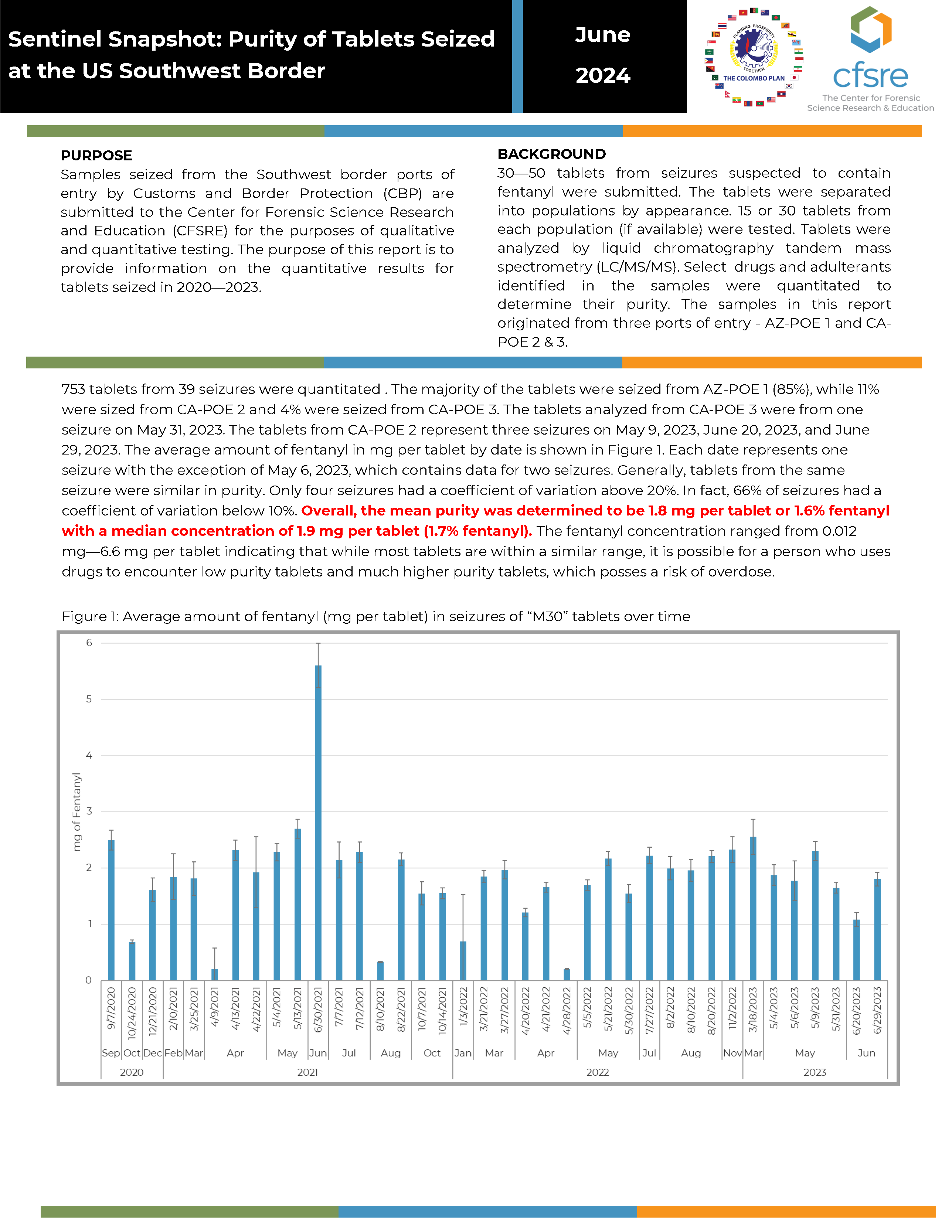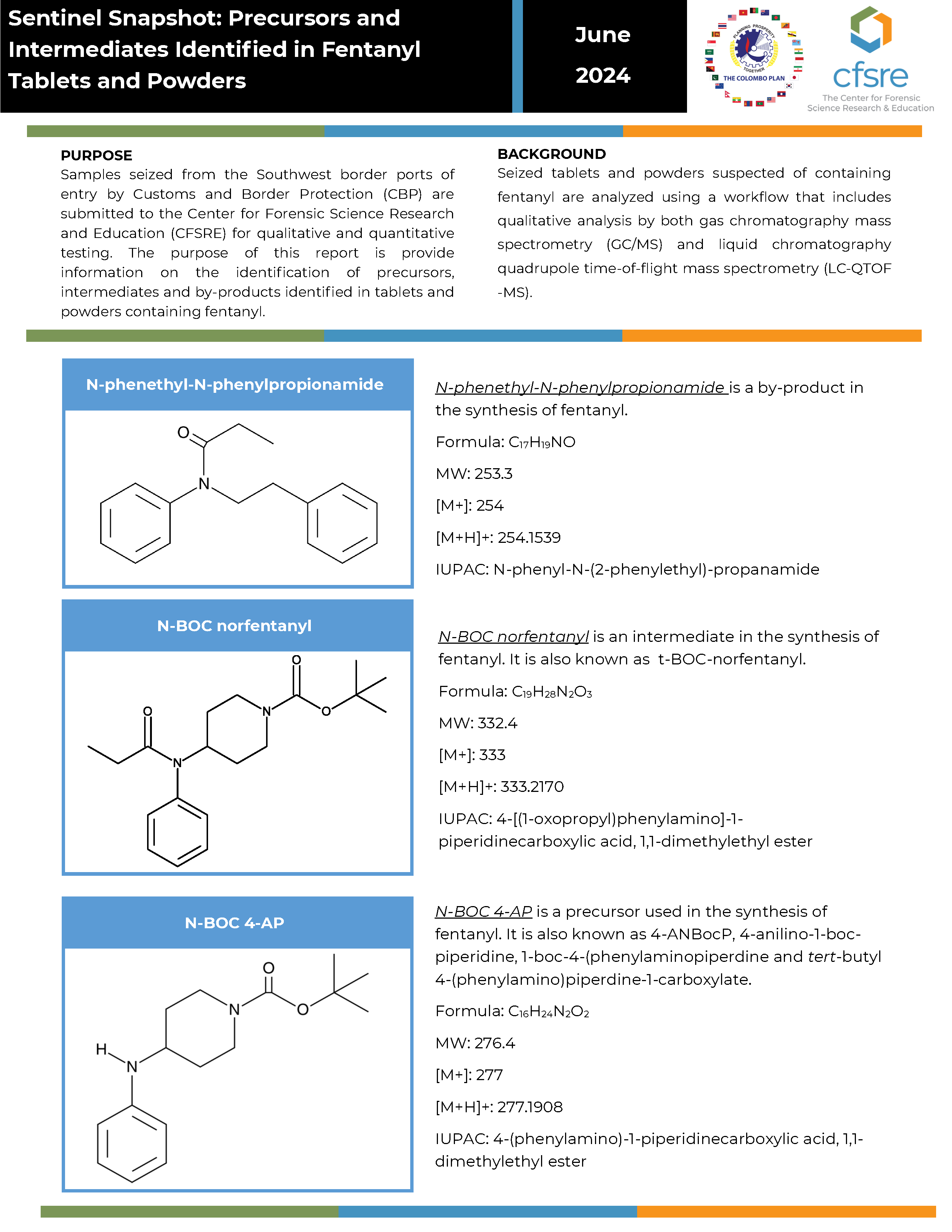Public Alerts
Purpose: In collaboration with the Drug Enforcement Administration (DEA), the Center for Forensic Science Research and Education (CFSRE)’s NPS Discovery program has developed this report to notify public health, public safety, forensic and clinical laboratories, clinicians, medical examiners and coroners, and all other related communities about new information surrounding the emergent adulterant BTMPS and newly discovered fentanyl-related substances.
Summary: BTMPS has been detected in all regions across the United States, demonstrating vast prevalence. BTMPS has appeared in more than 600 drug materials tested by our laboratory. Tetramethyl-4-piperidinol (TMP) was first detected in August 2024 and since has appeared in more than 20 drug materials. Tetramethyl-4-AP (TM-4-AP) and tetramethylnorfentanyl (TMNF) were first detected in April 2025 and since have appeared in more than ten drug materials, often together. To date, a substance suspected of being tetramethylfentanyl (TMF) has been identified in only small (or trace) amounts alongside these other related substances; however, confirmation of this substance is pending acquisition of standard reference material.
Public health and public safety officials worldwide should be aware of an emerging threat of the Benzimidazole (Nitazene) class of opioids, which are causing increased mortality (death) and morbidity. Considered several times more potent than the fentanyl class of opioids (phenylpiperidines), these compounds can make an existing opioid epidemic much worse or introduce an epidemic to unsuspecting countries and regions.
In 2023, nitazene tablets destined for Florida, Connecticut, and Brazil containing an average of 29 mg of metonitazene across multiple shipments were seized in the U.S. from international express mail. This amount is equivalent to 290 mg of fentanyl in a single tablet (or 145 times the DEA’s estimated fatal dose of fentanyl), which would be highly lethal.
DOWNLOAD THE ALERT
ortho-Methylfentanyl is an active mu-opioid receptor agonist with potency similar to that of fentanyl. ortho-Methylfentanyl bears structural resemblance to fentanyl and fentanyl analogues (e.g., para-fluorofentanyl). ortho-Methylfentanyl is synthetically manufactured and can appear in three positional isomeric forms: ortho-, meta-, and para-methylfentanyl. ortho-Methylfentanyl is a Schedule I drug in the United States under the Controlled Substances Act (21 CFR 1308). The effects of ortho-methylfentanyl are similar to those of fentanyl, including analgesia, sedation, drowsiness, euphoria, etc., and in severe intoxication cases respiratory depression and death.
ortho-Methylfentanyl is the latest synthetic opioid to appear in the recreational drug supply with increasing regularity in North America. ortho-Methylfentanyl is often identified alongside fentanyl and/or para-fluorofentanyl in drug materials and biological specimens. ortho-Methylfentanyl first emerged in early 2023 in British Columbia, Canada, and since initial identification, ortho-methylfentanyl has been confirmed in >200+ forensic specimens originating from Canada and the United States.
Project Overview: The objective of this project was to perform a survey of toxic adulterants in seized materials from across the United States.
Study Design and Methods: A total of 2,031 seized drug extracts were submitted to the CFSRE for testing. Laboratories were contacted and requested to submit seized drug extracts suspected of containing opioids (heroin/fentanyl), methamphetamine and/or cocaine. Samples were analyzed using a using a Waters ACQUITY UPLC® I Class Waters Xevo® G2-S QTOF. Analytical separation was achieved using an ACQUITY UPLC® BEH C18 (2.1 mm x 150 mm, particle size 1.8 micron) column at 50˚C with a flow rate of 0.4 mL per minute and 5 µL injection. The Xevo® G2-S QTOF operated in positive electrospray ionization resolution mode (50-1000 m/z) with collision energy of 10-40 eV. Samples were processed against a library containing over 1100 drugs, adulterants and precursors/by-products. Criteria for calling a sample positive included: a clearly identifiable chromatograph peak within ±0.25 minutes of analyte in database, an observed mass of the molecular ion within ± 5ppm of mass in database, an observed mass of fragment ion within ± 2mDa, and a response greater than 800 (in the 3D data).
PURPOSE: Samples seized from the Southwest border ports of entry by Customs and Border Protection (CBP) were studied by the Center for Forensic Science Research and Education (CFSRE) using advanced qualitative and quantitative testing methods at our state-of-the-art facility in Horsham, PA. This testing provides information related to understanding the health risks involved from variable drug potency and adulteration in the illicit fentanyl supply.
BACKGROUND: Seized powders suspected of containing fentanyl were analyzed at CFSRE qualitatively by gas chromatography mass spectrometry (GC/MS) and quantitatively by liquid chromatography tandem mass spectrometry (LC/MS/MS). Select drugs and adulterants identified in the samples were quantified to determine the purity. Thirty-three samples seized between 2020 and 2023 were analyzed originating from seven ports of entry designated as AZ-POE 1 and 2, TX-POE 1-3, and CA-POE 1-2.
PURPOSE: Samples seized from the Southwest border ports of entry by Customs and Border Protection (CBP) are submitted to the Center for Forensic Science Research and Education (CFSRE) for the purposes of qualitative and quantitative testing. The purpose of this report is to provide information on the quantitative results for tablets seized in 2020—2023.
BACKGROUND: 30—50 tablets from seizures suspected to contain fentanyl were submitted. The tablets were separated into populations by appearance. 15 or 30 tablets from each population (if available) were tested. Tablets were analyzed by liquid chromatography tandem mass spectrometry (LC/MS/MS). Select drugs and adulterants identified in the samples were quantitated to determine their purity. The samples in this report originated from three ports of entry - AZ-POE 1 and CA-POE 2 & 3.
PURPOSE: Samples seized from the Southwest border ports of entry by Customs and Border Protection (CBP) were submitted to the Center for Forensic Science Research and Education (CFSRE) for the purposes of qualitative and quantitative testing. The purpose of this report is to provide information on the substances identified in counterfeit tablets seized in 2020—2023.
BACKGROUND: CBP seizes counterfeit tablets monogrammed “M30” that have the appearance of pharmaceutical oxycodone, but are suspected to contain fentanyl. These tablets were analyzed by gas chromatography/mass spectrometry (GC/MS). A total of 1,219 originating from 81 seizures were analyzed. The scope of the GC/MS analysis includes about 11,00 compounds including controlled substances, pharmaceuticals, synthesis precursors and by-products, and adulterants.
PURPOSE: Samples seized from the Southwest border ports of entry by Customs and Border Protection (CBP) are submitted to the Center for Forensic Science Research and Education (CFSRE) for qualitative and quantitative testing. The purpose of this report is provide information on the identification of precursors, intermediates and by-products identified in tablets and powders containing fentanyl.
BACKGROUND: Seized tablets and powders suspected of containing fentanyl are analyzed using a workflow that includes qualitative analysis by both gas chromatography mass spectrometry (GC/MS) and liquid chromatography quadrupole time-of-flight mass spectrometry (LC-QTOF-MS).
2F-2oxo-PCE is a novel synthetic hallucinogen that bears structural resemblance to ketamine and previously encountered novel dissociatives (e.g., hydroxetamine, MeO-PCE, and HO-PCE). 2F-2oxo-PCE is a positional isomer of fluorexetamine (also known as FXE or 3F-2oxo-PCE). Ketamine is regulated by the U.S. Drug Enforcement Administration (DEA) as a Schedule III drug under the Controlled Substances Act; however, neither 2F-2oxo-PCE nor fluorexetamine are currently scheduled substances. There is limited pharmacological information for 2F-2oxo-PCE; however, it is understood that 2F-2oxo-PCE is an active drug and it is hypothesized to act similarly to ketamine in vivo producing dissociative effects.
2F-2oxo-PCE was first reported in early 2022 by the Australian drug checking service CanTEST. Scientists in Canberra, Australia, first referred to the novel, unknown ketamine-like drug as “CanKet” before confirming its structure. Later that year, in December 2022, CFSRE’s NPS Discovery reported our first case involving an indiscriminate isomer of “fluorexetamine” by LC-QTOF-MS analysis only. As of May 2024, 2F-2oxo-PCE has now been identified in more than 20 drug materials and 35 toxicology specimens. More than 60% of the drug materials containing 2F-2oxo-PCE also contained opioids, primarily fentanyl. Xylazine, NPS benzodiazepines, and nitazene analogues were common co-occurrences alongside 2F-2oxo-PCE. Cases originated from at least nine states or provinces across the U.S. and Canada. In five postmortem cases, ages ranged from approx. 20 to 40 years. The toxicity of 2F-2oxo-PCE has not been formally examined but recent associations with intoxication and death lead professionals to believe that this drug has the potential to cause harm and is of high public health concern, when mixed with other drugs or when consumed alone at high doses.
Purpose: The objective of this announcement is to notify public health, harm reduction, first responders, clinicians, medical examiners and coroners, forensic and clinical laboratories, and all other related communities about new information surrounding the emergent adulterant medetomidine (also referred to as dexmedetomidine).
Background: Medetomidine is an alpha-2 agonist, belonging to the same family of drugs as xylazine and clonidine. Medetomidine is synthetically manufactured and exists in two enantiomeric forms: dexmedetomidine and levomedetomidine, the former being active and potent. Dexmedetomidine is approved for use in humans and is administered in hospital, while differing forms of medetomidine are available for use in veterinary medicine. The effects of medetomidine can include sedation, analgesia, muscle relaxation, anxiolysis, bradycardia, hypotension, hyperglycemia, and hallucinations. Duration of action is noted to be longer for medetomidine relative to xylazine.
Summary: Medetomidine is the latest CNS depressant to appear as an adulterant alongside fentanyl in the recreational drug supply. Recent mass overdose outbreaks in Philadelphia, Chicago, and elsewhere have all been associated with fentanyl or heroin drug products containing medetomidine, as well xylazine and/or other substances. In cases where medetomidine ingestion is suspected or confirmed, severe adverse effects have been noted, including heightened sedation and profound bradycardia. In December 2023, the CFSRE and the Colombo Plan issued a Toxic Adulterant Alert for medetomidine following its emergence in the recreational drug supply.



